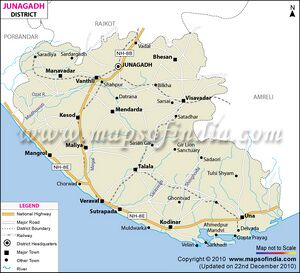Bava Pyara
| Author:Laxman Burdak, IFS (R) |

Bava Pyara (बवाप्यारा) are caves situated in the eastern part of Junagadh of the Indian state of Gujarat. Bava Pyara caves contains artworks of both Buddhism and Jainism.
Origin
Variants
- Baba Pyara caves
- Baravapyara बरवाप्यारा, जिला जूनागढ़, सौराष्ट्र, गुजरात, (AS, p.609)
- Babapyara बाबाप्यारा, जिला जूनागढ़, सौराष्ट्र, (AS, p.621)
Caves
The Bava Pyara caves were visited by James Burgess, an English archaeologist and founder of The Indian Antiquary. He concluded that they were affiliated with both Buddhism and Jainism. According to Burgess these caves were initially built for Buddhists bhikkhus and were in a later period occupied by Jain ascetics. He was not certain about the exact age of the ancient caves. One fragmentary inscription was found in Bava Pyara cave that affirms its affiliation to Jainism, because one term in that inscription is exclusively used by Jains. The inscription was read as "केवलज्ञान संप्राप्तानां जीतजरामरणानां ".[1][2][3]
The term kevalgyan was used exclusively by Jains. Scholar H. D. Sankalia attributes these caves to Jainism because of some auspicious symbols typical of Jainism that are depicted above the door's frame. Sankalia recorded about eleven auspicious symbols, "Nandhyavarta", "Swastika", "Darpan", "Bhadrasana", "Meen Yugal" and "Purna Ghata". Such symbols were also found on Ayagpattas from Kankali Teela Mathura. About five such symbols are found in another cave of Bava pyara Caves. These symbols are in a bad state and not recorded, although they were identified as Darpan, Meen Yugal, Purna Ghat, Meen Yugal, Darpan. On a small entrance of one of the caves in the second row at the south end are two symbols depicting Vyala figures. Burgess and Sanklia failed to notice them. According to Madhusudan Dhaky, on the basis of the Vyala figure, the Bava pyara cave is from the 2nd or 3rd century AD.[4] Sankalia claimed that the Chaityagruh containing cave should be at least from the 2nd century BC, and caves with symbols carving should be hailed from 2nd or 3rd century AD.[5]
History
बरवाप्यारा
विजयेन्द्र कुमार माथुर[6] ने लेख किया है .....बरवाप्यारा गुफ़ाएँ (AS, p.609) जूनागढ़ ज़िला, सौराष्ट्र, गुजरात में स्थित हैं। जूनागढ़ के निकट बरवाप्यारा की कई शैलकृत्त गुफ़ाएँ हैं, जो जैन भिक्षुओं के निवास तथा पूजा आदि के लिए बनाई गईं थीं। इन गुफ़ाओं के अंदर स्वास्तिक कलश, नंदिपद, मुद्रासन, मीनयुगल आदि जैनों के धार्मिक चिन्ह अंकित हैं।
बाबाप्यारा
विजयेन्द्र कुमार माथुर[7] ने लेख किया है .....बाबाप्यारा (AS, p.621) की गुफ़ाएँ जूनागढ़ ज़िला, सौराष्ट्र में स्थित हैं। ये गुफ़ाएँ अब बाबाप्यारा का मठ कहलाती हैं। गिरनार पर्वत पर पहुँचने के लिए जो मार्ग बागेश्वरी द्वार से जाता है, उसी पर इस द्वार के पास ही बाबाप्यारा नाम की मौर्य सम्राट अशोक के काल की गुफ़ाएँ स्थित हैं। रुद्रदामन तथा अशोक के प्रसिद्ध अभिलेखों वाली चट्टान भी इसके पास ही स्थित है।
External links
References
- ↑ Hasmukh Dhirajlal Sankalia (1941). The Archaeology of Gujarat: Including Kathiawar. Natwarlal & Company. pp. 47–49.
- ↑ Aspects of Jaina art and architecture, Umakant Premanand Shah, Madhusudan A. Dhaky Gujarat State Committee for the Celebration of 2500th Anniversary of Bhagavān Mahāvīra Nirvāna : distributors, L.D. Institute of Indology, 1975, page no. 75
- ↑ Journal of the Oriental Institute, Volume 49, page no. 83
- ↑ Aspects of Jaina art and architecture, Umakant Premanand Shah, Madhusudan A. Dhaky Gujarat State Committee for the Celebration of 2500th Anniversary of Bhagavān Mahāvīra Nirvāna : distributors, L.D. Institute of Indology, 1975, page no. 77–78
- ↑ Hasmukh Dhirajlal Sankalia (1941). The Archaeology of Gujarat: Including Kathiawar. Natwarlal & Company. pp. 47–49.
- ↑ Aitihasik Sthanavali by Vijayendra Kumar Mathur, p.609
- ↑ Aitihasik Sthanavali by Vijayendra Kumar Mathur, p.621

